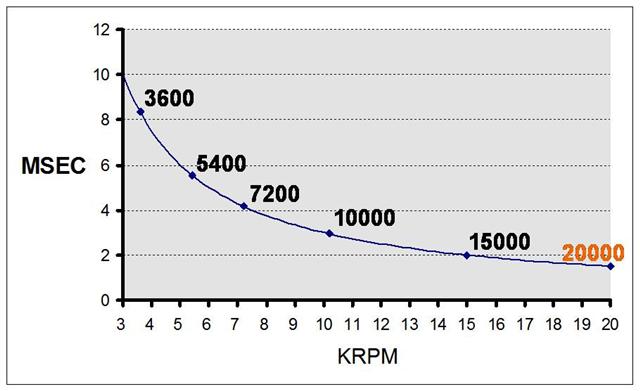When you look at disk transfer rates, it’s pretty obvious that the faster you spin them, the lower the rotational latency and the better the transfer rates. It’s also very clear that disk transfer rates are improving much slower than memory subsystem bandwidth. Why not rotate disks faster? We’ve had 15,000 RPM enterprise disk for a considerably long time. Why have there been no recent improvements on this dimension?
The reason I’ve long understood is that power consumption scales cubically with the RPM but there is more to it than that. I recently came across a claim that power scaled to the fifth power with RPM. That didn’t seem right so I decided to go check the facts. I asked Dave Anderson of Seagate Research if he could help chase down the real data. By the way, if you ever get a chance to see Dave speak, jump on it. He knows an enormous amount about all aspects of spinning media technology and, when he really get down to the details, it’s amazing that disk can work at all. At the outside edge of a 15,000 RPM drive, the platter is going by the head at 118 MPH, the head is flying at 0.5 microinches (less than the wavelength of visible light), the track width is less than 1/300 the width of a page, nearby vibration sources such as other disks mean the platter will be vibrating slightly and there is always some non-repeatable runout (NRRO). As the tracks shoots by the disk, the blocks need to be read, decoded, identified to ensure the right block was read, and error checked so significant computational work needs to be done as well. Phenomenal technology.
Disks really are amazing but returning to why RPMs haven’t been increasing of late, I checked with Dave Anderson a senior engineer at Seagate. The short answer is cost. As RPM is increased, NRRO increases quickly, as does vibration both leading to serious tracking complexity. The cost of the drive motors goes up, air drag increased dramatically, as does power consumption. What’s exact relationship for disk power consumption as a function of RPM? From Dave:
There are 2 general cases for power consumption today, a cube relation for the general case, and a square relation, where the discs are packed so closely together, they approximate a cylinder.
Apparently there can still be a **4 condition where there is extensive turbulence in a single disk drive.
Power consumption going up cubically is problematic but enterprise disk today only draw 15 to 18W each. I would never recommend wasting power but many deployments need to use more disks to get the performance they need. In effect the power is often getting spent to support the given workload anyway. Would less power be consumed by fewer, faster disks? Further complicating the equation and making that gain harder to find, rotational latency improvements diminish rapidly as RPM goes up. The improvement from the current high of 15,000 RPM to say 20,000 RPM isn’t very significant:
.jpg)
Dave Anderson Chart
I suspect we will see increased RPM in the future but increase in cost and power coupled with diminishing returns and far increased complexity from all the factors listed above suggest we’ll not see the RPM going up very quickly in the future. Some speculate, we’ve seen the last RPM increase but I’ve never been a subscriber of hit-the-wall theory. We always eventually find a way.
–jrh
James Hamilton, Windows Live Platform Services
Bldg RedW-D/2072, One Microsoft Way, Redmond, Washington, 98052
W:+1(425)703-9972 | C:+1(206)910-4692 | H:+1(206)201-1859 | JamesRH@microsoft.com